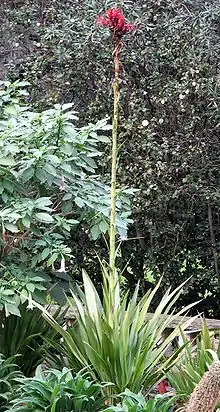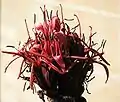Doryanthes excelsa
Doryanthes excelsa, commonly known as the gymea lily, is a flowering plant in the family Doryanthaceae that is endemic to coastal areas of New South Wales near Sydney. It has sword-like leaves more than 1 metre (3 ft) long and it grows a flower spike up to 6 metres (20 ft) high. The apex of the spike bears a large cluster of bright red flowers, each 10 centimetres (4 in) across. Its common name is derived from the name given to the plant by the indigenous [Dharawal] people. The Sydney suburbs of Gymea and Gymea Bay are named after the lily.
| Gymea lily | |
|---|---|
 | |
| Gymea lily in the Royal Botanic Gardens, Sydney | |
| Scientific classification | |
| Kingdom: | Plantae |
| Clade: | Tracheophytes |
| Clade: | Angiosperms |
| Clade: | Monocots |
| Order: | Asparagales |
| Family: | Doryanthaceae |
| Genus: | Doryanthes |
| Species: | D. excelsa |
| Binomial name | |
| Doryanthes excelsa | |
| Synonyms[1] | |
| |
Description
Gymea lilies have a rosette of large numbers of sword-shaped, strap like leaves 1–2.5 metres (3–8 ft) long and 10 centimetres (4 in) wide. The leaves are bright green, fibrous and glabrous.[2][3]
In winter the flower spike grows from the centre of the rosette until it is up to 6 metres (20 ft) high, bearing shorter leaves up to 30 centimetres (10 in) long. At the top of the spike, a head of flowers 30 centimetres (10 in) in diameter develops, each flower being bright red, trumpet-shaped and about 10 centimetres (4 in) long. The head is surrounded by reddish-brown bracts, sometimes making it difficult to see the flowers from the ground. Flowering occurs in spring and is followed by oval-shaped reddish-brown capsules, 7–10 centimetres (3–4 in) long. In late summer, the capsule splits open and releases the seeds which are 15–23 millimetres (0.6–0.9 in) long.[2][3]
Taxonomy and naming
Doryanthes excelsa was first formally described in 1802 by the Portuguese polymath, José Correia da Serra from the type specimen collected by George Bass "in mountainous parts of the colony of N.S.W.". The description was published in Transactions of the Linnean Society of London.[4][5] The genus name (Doryanthes) is derived from the Ancient Greek δόρυ (dóry) meaning a "spear"[6]: 277 and ἄνθος (ánthos) meaning "a flower".[6]: 338 The specific epithet (excelsa) is a Latin word meaning "high", "lofty" or "distinguished".[6]: 410 Doryanthes excelsa and Doryanthes palmeri are the only two members of the family Doryanthaceae.[3]
"Doryanthes" has inspired the naming of the journal of history and heritage for Southern Sydney founded by Dharawal historian Les Bursill.[7]
Distribution and habitat
Doryanthes excelsa occurs in woodland and dry sclerophyll forest in coastal areas and adjacent mountains from Karuah to Mount Keira. It usually grows in soils derived from sandstone.[2]
Uses
Indigenous use
Aboriginal people roasted the young stems of gymea lily for eating. They also roasted the roots to make a kind of cake. Fibres from the leaves were used for making brushes and matting.[8]
Horticulture
Gymea lilies are hardy and adaptable plants often used in landscape gardening, not only in the Sydney region but also in other coastal areas such as Brisbane and Perth. Plants can be grown from seed but may not flower for up to eight years. Flowering can be encouraged by fire and by carefully placing a stone in the centre of the rosette.[3][9][10]
Image gallery
 Flowers
Flowers Flowers
Flowers Flowers and past seeds
Flowers and past seeds Illustration
Illustration Sword-like leaves
Sword-like leaves Australian native growing in Heathcote National Park, Sydney
Australian native growing in Heathcote National Park, Sydney Habit
Habit Seed head
Seed head
See also
References
- "Doryanthes excelsa". Australian Plant Census. Retrieved 13 November 2019.
- Wilson, K.L. "Doryanthes excelsa". Royal Botanic Gardens Sydney, Plantnet. Retrieved 18 November 2015.
- Rymer, Julia. "Doryanthes excelsa". Australian National Botanic Garden. Retrieved 18 November 2015.
- "Doryanthes excelsa". APNI. Retrieved 13 November 2019.
- Correia da Serra, Jose (1802). "On the Doryanthes, a new genus of plants from new Holland". Transactions of the Linnean Society of London. 6: 211–213. Retrieved 18 November 2015.
- Brown, Roland Wilbur (1956). The Composition of Scientific Words. Washington, D.C.: Smithsonian Institution Press.
- A Southern Sydney Journal of History, Heritage and the Arts. Doryanthes. February 2011. ISBN 9781925078060.
- "Aboriginal plant use in S.E. Australia". Australian National Botanic Garden. Retrieved 18 November 2015.
- "Doryanthes excelsa". Australian Native Plants Society Australia. Retrieved 18 November 2015.
- "Fact Sheet: Gymea Lilies". Australian Broadcasting Corporation, Gardening Australia. Retrieved 18 November 2015.
External links
- Doryanthes excelsa Occurrence data from Australasian Virtual Herbarium
 Media related to Doryanthes excelsa at Wikimedia Commons
Media related to Doryanthes excelsa at Wikimedia Commons